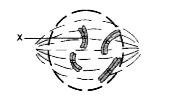In bryophytes, the diploid number of chromosomes occurs in
Gametes
Spores
Nuclei of gametophyte
Spore mother cells
The correct Answer is:4
Step-by-Step Solution:
1. Understanding Bryophytes:
- Bryophytes are non-vascular land plants, which include mosses and liverworts. They lack vascular tissues like xylem and phloem.
2. Life Cycle of Bryophytes:
- Bryophytes exhibit a life cycle known as alternation of generations, consisting of two distinct phases: the haploid gametophyte phase and the diploid sporophyte phase.
- The gametophyte phase is the dominant phase and is haploid (n), meaning it has a single set of chromosomes.
3. Identifying the Phases:
- The gametophyte phase (haploid) produces gametes (sperm and eggs).
- The sporophyte phase (diploid) produces spore mother cells, which are diploid.
4. Analyzing the Options:
- Gametes: These are produced in the gametophyte phase and are haploid.
- Spores: These are produced from spore mother cells through meiosis and are also haploid.
- Nuclei of Gametophytes: These are haploid since they are part of the gametophyte generation.
- Spore Mother Cells: These are found in the sporophyte phase and are diploid (2n).
5. Conclusion:
- The diploid number of chromosomes in bryophytes occurs in spore mother cells.
Final Answer:
In bryophytes, the diploid number of chromosomes occurs in spore mother cells.
- Bryophytes are non-vascular land plants, which include mosses and liverworts. They lack vascular tissues like xylem and phloem.
- Bryophytes exhibit a life cycle known as alternation of generations, consisting of two distinct phases: the haploid gametophyte phase and the diploid sporophyte phase.
- The gametophyte phase is the dominant phase and is haploid (n), meaning it has a single set of chromosomes.
- The gametophyte phase (haploid) produces gametes (sperm and eggs).
- The sporophyte phase (diploid) produces spore mother cells, which are diploid.
- Gametes: These are produced in the gametophyte phase and are haploid.
- Spores: These are produced from spore mother cells through meiosis and are also haploid.
- Nuclei of Gametophytes: These are haploid since they are part of the gametophyte generation.
- Spore Mother Cells: These are found in the sporophyte phase and are diploid (2n).
- The diploid number of chromosomes in bryophytes occurs in spore mother cells.
In bryophytes, the diploid number of chromosomes occurs in spore mother cells.
Topper's Solved these Questions
- REPRODUCTION IN ORGANISMS BOOK - CENGAGE BIOLOGY ENGLISHCHAPTER - REPRODUCTION IN ORGANISMS EXERCISE - ARCHIVES
8 Videos
- ORGANISMS AND POPULATIONSBOOK - CENGAGE BIOLOGY ENGLISHCHAPTER - ORGANISMS AND POPULATIONSEXERCISE - ARCHIVES (Choose the correct options)
29 Videos
- REPRODUCTIVE HEALTHBOOK - CENGAGE BIOLOGY ENGLISHCHAPTER - REPRODUCTIVE HEALTHEXERCISE - ARCHIVES
19 Videos
Similar Questions
Knowledge Check
Given below is a diagram representing a stage during mitotic cell division. Answer the questions that follow:

What is the diploid number of chromosomes shown in the diagram?A6B2C4D8Given below is a diagram representing a stage during mitotic cell division Answer the questions that follow:

What is the diploid number of chromosomes shown in the diagram?A6B2C4D8
What is the diploid number of chromosomes in gorilla, chimpanzee and orangutan.
View SolutionThe total amount of DNA in human diploid cells is not dissimilar from that of chimpazee but the diploid number of chromosomes in chimpanzee is
View SolutionWhich one of the following pairs of plant structures has diploid number of chromosomes
View SolutionMore than 200 chromosomes occur in
View SolutionDecondensation of chromosomes occurs during
View SolutionA plant species A has a diploid number of chromosomes as 12. Another plant species B has a diploid chromosome number off 16. The allopolyploid developed. By hybridization of A and B shall have a diploid chromosome number as
View Solution
